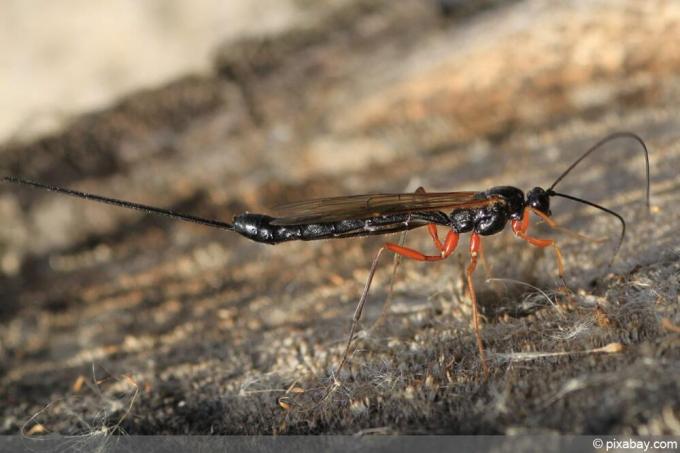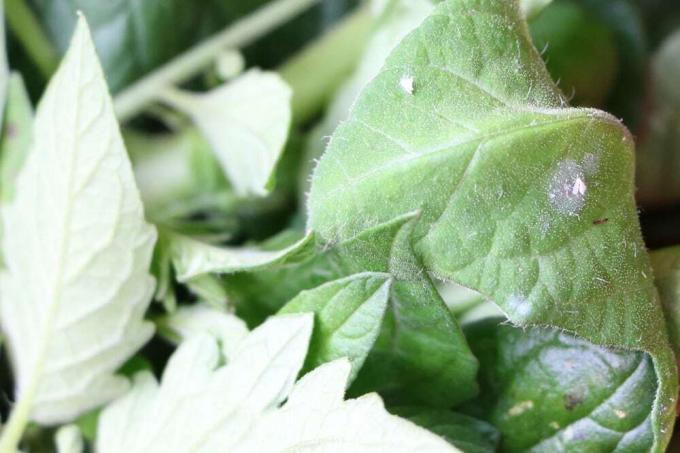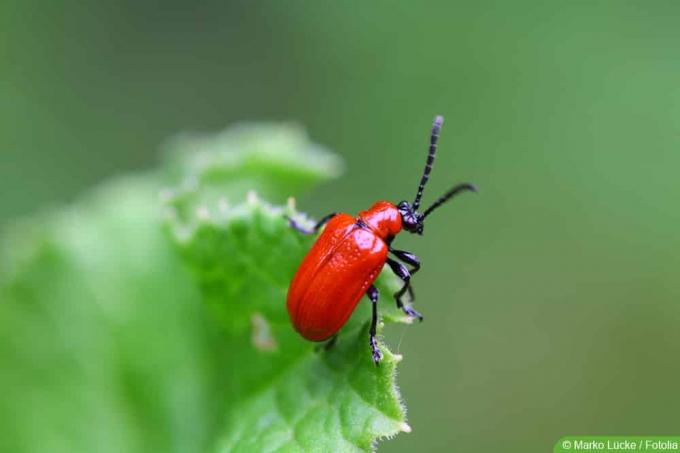

Table of contents
- detect infestation
- prevention
- parasitic wasps
- isolate plants
- yellow sticker
- Natural means of combating
- Conclusion
If a whitefly infestation is found in the greenhouse, action must be taken quickly. Because the relative of the lice has wings in contrast to these and can settle so quickly on all plants. It is a pest that sucks the leaves of plants and should therefore be combated as soon as an infestation is first detected. Originally native to the tropical regions of the world, it feels particularly at home in warm, humid greenhouses.
detect infestation
Whiteflies like the vegetables and tropical plants in the greenhouse. Because it's humid and warm here, just the way they like it. Temperatures around 20° Celsius and high humidity of around 70% are ideal for settling and propagation. They feel really comfortable in such an environment. It is therefore important to regularly examine the plants in a greenhouse in order to detect an infestation as quickly as possible. With a size of 2 to 3 millimeters, the pest is usually not directly recognizable at first glance. If the hobby gardener discovers just one white fly on a leaf, it is usually the case that the infestation is much more advanced and other pests are already in the area. Since the whitefly can lay up to 500 eggs, reproduction is also very fast. Whitefly infestation can be recognized as follows:
- look under the leaves
- likes to sit on the underside of cabbage leaves
- Affected leaves can be recognized by a yellow speckle
- the insects suck the sap of the plants
- the leaves fall off after a while
- if there is a disturbance, the pests fly up in droves
- the insects also secrete honeydew
- this can be seen by the sticky spots on leaves
- this can cause sooty mold to form on the plant
- tomato plants and other fruits are also readily attacked
- also occur on cucumber plants
Tip:
If an infestation is detected, the entire plant is not immediately affected. Although she loses the affected leaves, since the whitefly does not attack the stalk or stalk of a plant, it can continue to grow unhindered. If the infestation has been fought, new leaves can be formed again.
prevention
Prevention is particularly important in closed rooms, because here the pests have the opportunity to spread quickly between the plants once they have entered. Therefore, the greenhouse should always be well ventilated and the temperature should not be too hot. If the greenhouse is in the blazing sun in summer, it should be shaded from the outside. Excessive humidity also promotes an infestation. Further preventive measures can be taken to rule out an infestation in the greenhouse:
- Check new plants for infestation beforehand
- Whitefly also affects many ornamental plants
- check them before moving them to the greenhouse
- to be able to determine an initial infestation, put up yellow boards
- the pests stick to this
- so it can be recognized immediately when an infestation is in the early stages
parasitic wasps

A natural enemy of the whitefly are parasitic wasps. These are sold in packages to combat the pests. A single female parasitic wasp can destroy up to 300 insects. However, the parasitic wasps can only be used from March to September. They are usually available in cardboard cards with around 500 pupae and are hung in exactly this form in the infested greenhouse. It makes sense to attach several of these cards to the affected plants. When fighting with parasitic wasps, the following should also be observed:
- the cardboard cards can be stored for about 2 days in the refrigerator at 8° to 12° Celsius
- in the greenhouse they need warm conditions to hatch
- 18° to 27° Celsius are ideal
- humidity should be about 70%
- in these conditions the wasps hatch after two to four weeks
- if they find no more food, they die
- This means that once the whitefly infestation has been eliminated, the parasitic wasps will no longer survive either
- natural control is not so quick
- it may take a few weeks for the infestation to be eradicated
Tip:
However, combating parasitic wasps only makes sense if the plants have not been chemically treated for at least six weeks before use. Otherwise, this natural enemy of the whitefly could be harmed and the use would have no effect.
isolate plants
Was whitefly infestation newly detected in the greenhouse and so far only one or two plants infested, it is helpful to isolate the infested plants from the others and the location as soon as possible to change. Of course, this is easier if the plants have been cultivated in tubs in the greenhouse. Digging up an adult plant, on the other hand, makes less sense. If the affected plant was isolated, proceed as follows:
- – look for a new location
- – far from other plants
- – leave in a cool and airy place for a while
- – Keep humidity low
- – Ideally, the place is draughty or windy
- – the insects don’t like that kind of thing at all
- – unfortunately, such a location is not good for many plants
- – so keep a close eye on it
- - as soon as the whitefly has disappeared, put it back in the old location
yellow sticker
Yellow stickers are also available in well-stocked garden shops and are not chemical agents. These are small yellow stickers or larger panels with an adhesive layer. These can be used not only when an infestation is detected, but also as a preventive measure. Because the adult whitefly is attracted to the color yellow, flies to the stickers and sticks to them.
Natural means of combating

At the same time as the yellow stickers attached, a whitefly infestation can also be combated with natural household remedies. This is how you can take action against the pests with various home-made solutions:
- a solution of water and canola oil suffocates the pests
- a soft soap solution has also proven very effective
- the whitefly doesn't like basil
- Soak the herb in water and spray the affected plant
- this also works with stinging nettles
- Larvae, on the other hand, are destroyed by a shower of cold water
Tip:
The chemical solution should really always be the last solution if nothing else fights the whitefly. Because especially in a greenhouse with useful plants, such as various types of vegetables, tomatoes or cucumbers, it is not entirely harmless to your own health if insecticides are used.
Conclusion
It is not always necessary to proceed directly with the chemical club once the whitefly has settled in the greenhouse. Preliminary measures can already be taken when setting up the greenhouse, such as attaching yellow boards or yellow stickers in the various corners. If individual plants have been infested, they can be isolated immediately so that the whitefly does not spread. If this does happen, the natural predators, the parasitic wasps, can help get the infestation under control. However, good ventilation of the greenhouse can always prevent an infestation.
 garden editorial
garden editorial I write about everything that interests me in my garden.
Learn more about plant pests

White spots on leaves: what to do?
Whether in the home or in the garden, white spots on the leaves of your favorite plants are always a cause for concern. However, the causes can often be eliminated quickly. This guide summarizes the most common triggers and gives tips for quick help.

Cherry laurel has yellow eaten leaves: what to do?
Despite the robust nature of Prunus laurocerasus, it is occasionally attacked by pests and fungi. An infestation can be recognized by feeding damage and the discoloration of the leaves to yellow. You can find out how to combat and prevent the accumulation here.

Fighting grubs | Protect raised bed & lawn
Larvae of various species of beetles, grubs, can do a lot of damage in the garden. They live in the ground for several years and prefer to feed on roots. We present effective methods to combat the voracious pest or to effectively prevent an infestation.

Worms in cherries - 8 tips against maggots in cherries?
Worms in sweet cherries can spoil your appetite. It is a major nuisance when the entire cherry crop is affected. With these tricks you can contain the pest infestation and ensure that the insects do not multiply any further.

Fighting lily beetle - 11 effective home remedies
Lilies in the garden are beautiful to look at. There are the greatest types and varieties, all of which somehow have something special. Lily lovers can draw from the abundance of offers and look forward to the floral splendor. Lilies are actually quite hardy. There are few diseases and pests that can cause damage. However, the lily chicken can spoil the splendor.

Combating fungal infestation on trees: how to remove tree fungi
A tree fungus does not appear threatening, sometimes it is even interesting to look at. But that is deceptive. What we see is only the fruiting body, the mycelium is deep in the wood and destroys it slowly but purposefully. Eventually it kills the strongest tree.


